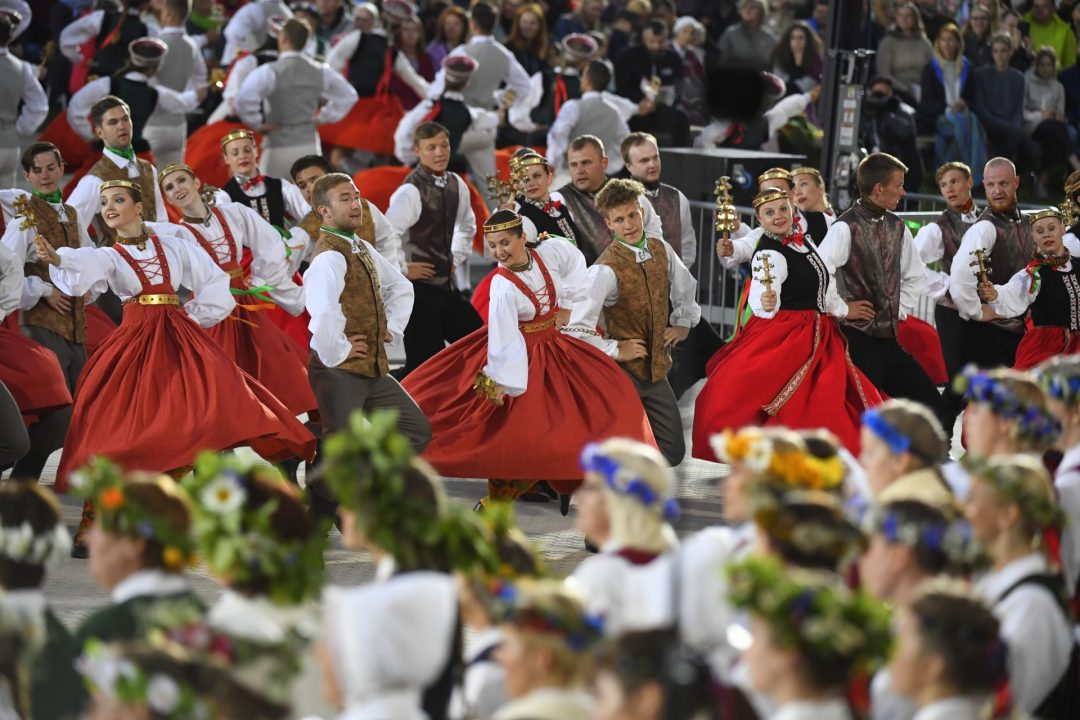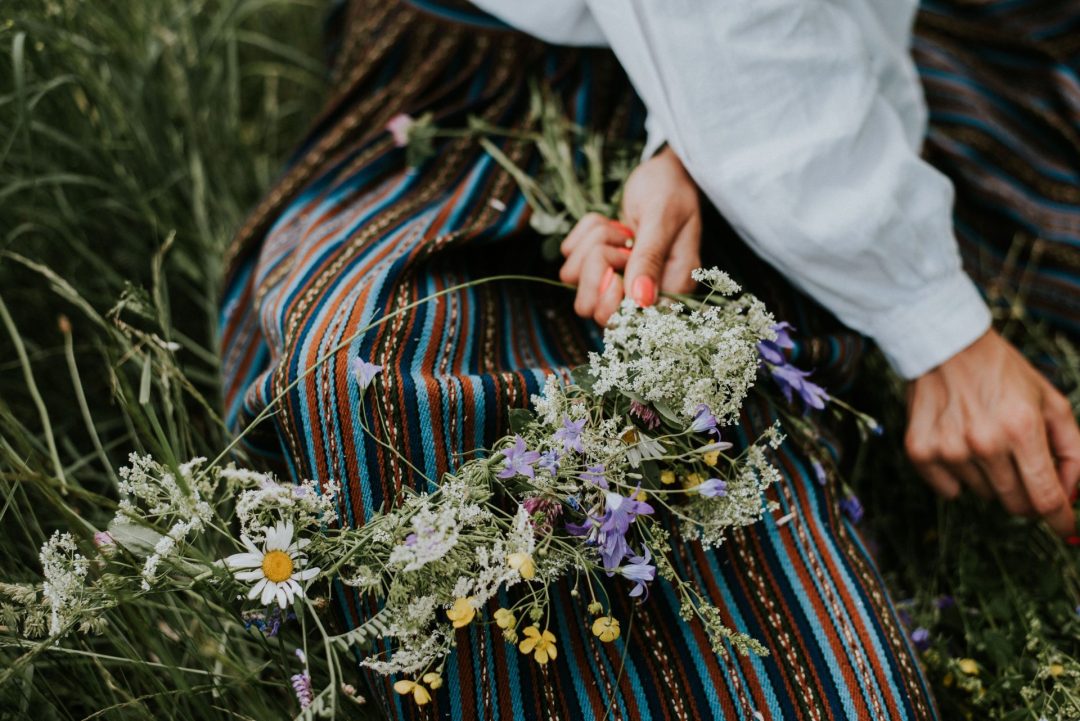The one-of-a-kind Song and Dance Festival
The Latvian Song and Dance Festival is one of the world’s largest amateur choral and dancing events and is recognized by UNESCO as a Masterpiece of the Oral and Intangible Heritage of Humanity.
The Latvian Song and Dance Festival is one of the world’s largest amateur choral and dancing events and is recognized by UNESCO as a Masterpiece of the Oral and Intangible Heritage of Humanity.
The celebration features a wide range of performances, from choir singing to dancing, instrumental music, wind orchestra music, and more. The choir singing, in particular, is a unique and powerful aspect of the celebration, showcasing the rich traditions of Latvian a cappella singing.
The closing concert at Mežaparks Open-Air Stage is a truly magical experience, as visitors are treated to the powerful voices of the choir and the mesmerizing choreography of the dancers, combining traditional Latvian folk elements with modern interpretations.
Midsummer’s Celebration is perhaps the most important and popular celebration in Latvia, held on the 23rd and 24th of June. Both days are recognized as national holidays in Latvia and are celebrated with a lot of excitement.
This tradition has its roots in an ancient pagan celebration that took place between planting and harvest time. The celebration involves staying awake throughout the shortest night of the year and participating in traditional activities such as lighting bonfires, singing, dancing, eating, and drinking. Most Latvians head to the countryside to celebrate and fully immerse themselves in the magic of the night, which is filled with singing and dancing around bonfires that are lit as the sun sets and burn until sunrise.
The celebration is steeped in traditional beliefs – some popular customs include jumping over the bonfire to avoid mosquito bites, wearing a wreath made of wildflowers to dream of one’s future spouse, and bathing naked in the morning dew for improved health and beauty. It’s also said that those who sleep through the midsummer night will continue to sleep all summer long. A fundamental tradition of the midsummer celebration is making and wearing wildflower wreaths. Women wear flower crowns made from daisies, cornflowers, and clover, while men wear oak leaf wreaths.
Interesting...
Traditional cheese (Jāņu siers), is a type of fresh sour milk cheese that is made with milk, curd, and caraway seeds. Beer is the drink of choice for the Latvian midsummer celebration, with many locals favoring local craft beers or even brewing their own.
Ancient Latvian culture is rich with traditions – most of which are closely linked to the seasons, the passing of time, and the sun’s journey throughout the year. These traditions are well preserved. One of the most notable is the summer solstice celebration, but there are many more with a plethora of unique activities, songs, and customs connected to each.
Celebrated in February or early March, seven weeks before Easter. The festival involves feasting and indulging in food and drink. Traditionally, parents toss gifts to their children from above, imitating the practice of the ancient goddess Laima, who is believed to distribute gifts from the heavens.
Participating in ‘ķekatas’, as it is known in Latvian, was a significant aspect of the entire winter season and its festivities. It involves dressing up in costumes and roaming from one neighbor’s house to the next – bursting in with loud songs and dances, demanding food and drink, and playing pranks on people. These mummers were believed to bring blessings and fertility to their hosts.
In Latvian folklore, the spring equinox, known as Lieldienas, represents the midpoint of spring when night and day are of equal length. The sun plays a significant role in the celebration, as its return and the lengthening of days signify its triumph over darkness. Similar to the Christian Easter holiday, hard-boiled eggs are a customary food item, symbolizing the beginning of life. They are customarily dyed in natural dyes, such as onion skins or red cabbage.
Winter solstice (or ziemassvētki) was significant in marking important changes in nature. One notable ritual is dragging a yuletide log throughout the homestead and fields, then setting it ablaze as a symbol of the beginning of a new life cycle
Mārtiņi occurs in November and signifies the midpoint between the autumnal equinox and winter solstice. Mārtiņi falls after the harvest, making it a celebration of prosperity with an abundance of delicious food – traditionally, a variety of meats along with root vegetables, cabbage, bread, apples, cranberries, and grey peas.
The four-lined dainas capture the ancient Latvian wisdom and are a poetic expression of Latvian daily life over the centuries. They not only form part of the cultural heritage of Latvia but are also recognized as powerful symbols of Latvian identity.
The tradition of crafting mittens finds its roots in the cold weather of Northern Europe, where functionality met artistry. And just like the dainas capture the wisdom of ancient Latvia, each mitten carries its own story, embedded in the symbols knitted with care.
Did you know?
The first written record of decorating an evergreen tree during Christmas was in 1510, of a tree that was decorated in Riga – a custom that was adopted by German merchants and then spread throughout the world.
Latvian crafts are showcased in the folk costumes, which are considered works of art due to the extensive handiwork involved in their creation. Weaving, embroidering, sewing, and crafting the various elements of a Latvian folk dress demands intricate skills. Each folk costume, originating from various regions across the country, boasts a diverse array of designs.
Another noteworthy aspect of Latvian costumes is the incorporation of ornaments or symbols, which are woven, forged, sewn, or embroidered into the fabric. The symbols adorning the costumes are associated with gods worshiped by the ancient Baltic tribes. Deities such as Laima, Māra, Ūsiņš, Jumis, and others were revered as protectors, and their power was invoked for good fortune.
The (usually) blue and brown costumes adorned with bronze jewelry are based on archaeological findings from the 7th to 13th centuries, during which the ancient Baltic and Liv tribes inhabited Latvia.
The more commonly seen Latvian folk costumes are the colorful and patterned ethnographic costumes, which originated from the Middle Ages and through the 18th and 19th centuries.
Each region had its own customary folk costume style, similar to Scottish tartans that can identify a clan. The more decorative costumes were reserved for special occasions, such as going to church, weddings, or christenings.
Latvian folk costumes are revered and maintained, and are to this day worn, mostly on special occasions. They are most typically seen at cultural performances (such as singing or dancing) and cultural celebrations (such as summer and winter solstice), but can also be seen at weddings, national days of celebration, and more.
The kokle is a plucked stringed instrument – the Latvian equivalent of the zither, which is recognized for its distinctive sound and musical characteristics. Unlike the zither, harp, and guitar, the kokle requires a unique playing technique where the right-hand index finger is used to strum, while the left hand mutes the strings by gently placing fingers on them. The kokle can be either placed in the player’s lap or laid down on a table.
The instrument has a rich history – archaeological excavations have unearthed kokles dating back to the 13th century, and the instrument is referenced in texts from as early as the 17th century. The National History Museum of Latvia has the oldest kokle in its collection, which dates back to 1710.
During ancient times, the kokle held a ritual significance and was associated with funeral rites. Today, the kokle has evolved into a national symbol and an integral part of Latvian identity. For instance, the kokle has a prominent role during the Song and Dance festival, where a concert of hundreds of players is dedicated to the instrument.
Modern musicians like Laima Jansone have also introduced the kokle’s unique and evocative atmosphere to the global audience.
The Proclamation Day is celebrated annually on November 18th to mark the 1918 declaration of independence. Events throughout the country include concerts, fireworks, and torchlight processions, with the largest one in the capital city, Riga, attracting thousands of participants. A modern tradition established in 2009 is for people worldwide to sing the Latvian national anthem at the same time – 21:00 EET. The celebration also involves a parade of the Latvian National Armed Forces, held in Riga, including the navy, National Guard units, and NATO allied countries since Latvia became a member in 2004.
Lāčplēsis Day is a memorial day for Latvian soldiers who fought for independence. Observed on November 11th, the day marks the decisive victory of the Latvian army over the West Russian Volunteer Army led by Count Pavel Bermondt-Avalov at the 1919 Battle of Riga. Lāčplēša Day is marked by services, parades, and candle lightings at Rīga Castle and other public places.
Fun fact: the fighting spirit of the Latvian Armed Forces was compared to “Lāčplēsis”, meaning “bearslayer”. This inspiration was drawn from the epic poem “Lāčplēsis” by Latvian poet Andrejs Pumpurs. The poem tells the story of the mythical hero Lāčplēsis during the Livonian Crusades and is considered the Latvian national epic.
The Day of the Restoration of Latvian Independence is an annual celebration that marks the declaration of the restored Latvian Republic. The “White Tablecloth Day” tradition invites people from different communities to come together and celebrate by gathering around a table with family and friends. The tradition of this day serves to remind people of the sacrifices made by those who fought for Latvian independence while also emphasizing the significance of community.




